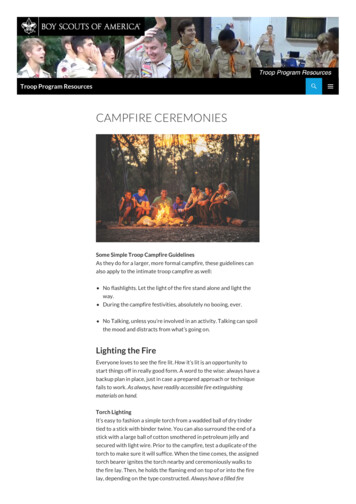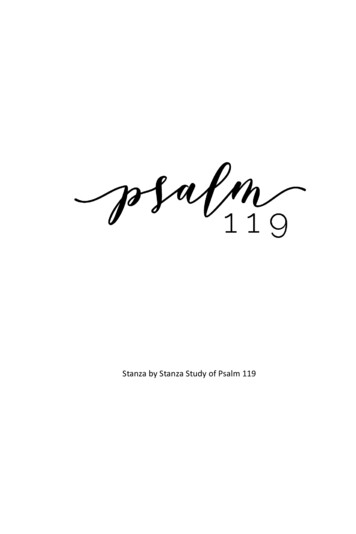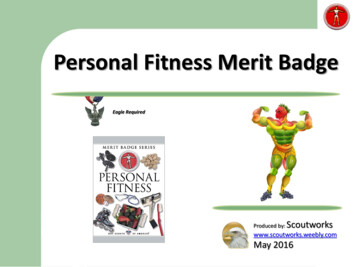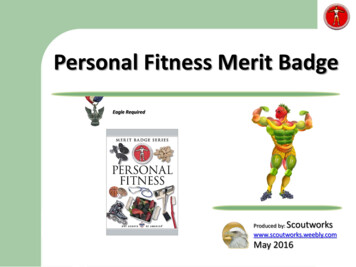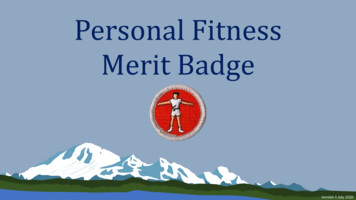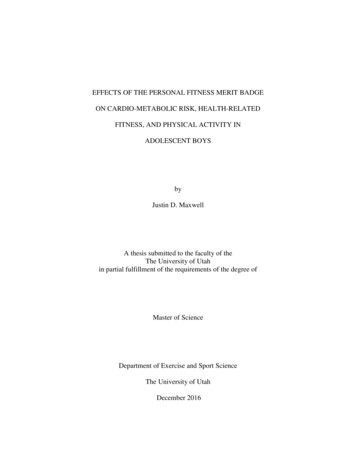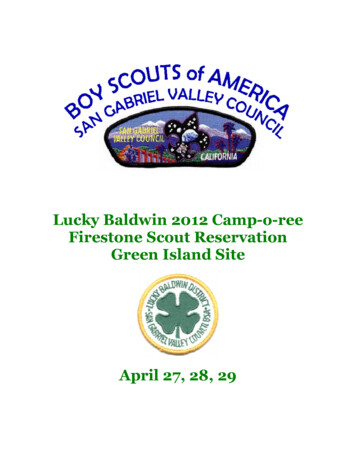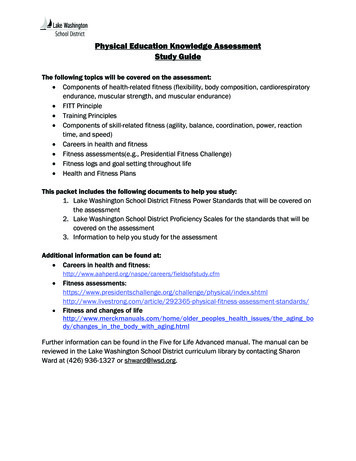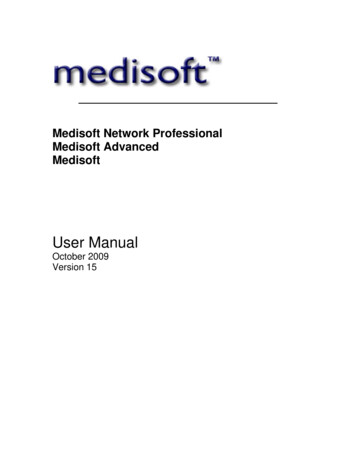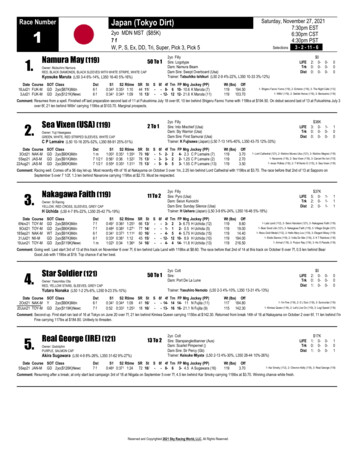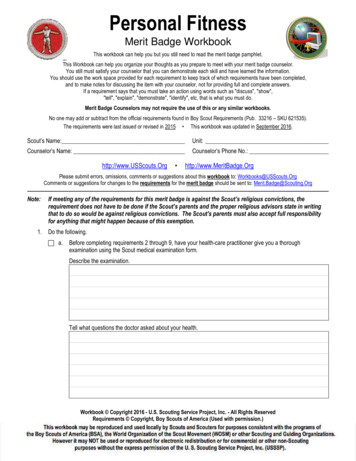
Transcription
Personal FitnessMerit Badge WorkbookThis workbook can help you but you still need to read the merit badge pamphlet.This Workbook can help you organize your thoughts as you prepare to meet with your merit badge counselor.You still must satisfy your counselor that you can demonstrate each skill and have learned the information.You should use the work space provided for each requirement to keep track of which requirements have been completed,and to make notes for discussing the item with your counselor, not for providing full and complete answers.If a requirement says that you must take an action using words such as "discuss", "show","tell", "explain", "demonstrate", "identify", etc, that is what you must do.Merit Badge Counselors may not require the use of this or any similar workbooks.No one may add or subtract from the official requirements found in Boy Scout Requirements (Pub. 33216 – SKU 621535).The requirements were last issued or revised in 2015 This workbook was updated in September 2016.Scout’s Name:Unit:Counselor’s Name:Counselor’s Phone No.:http://www.USScouts.Org http://www.MeritBadge.OrgPlease submit errors, omissions, comments or suggestions about this workbook to: Workbooks@USScouts.OrgComments or suggestions for changes to the requirements for the merit badge should be sent to: Merit.Badge@Scouting.OrgNote:If meeting any of the requirements for this merit badge is against the Scout’s religious convictions, therequirement does not have to be done if the Scout’s parents and the proper religious advisors state in writingthat to do so would be against religious convictions. The Scout's parents must also accept full responsibilityfor anything that might happen because of this exemption.1. Do the following. a.Before completing requirements 2 through 9, have your health-care practitioner give you a thoroughexamination using the Scout medical examination form.Describe the examination.Tell what questions the doctor asked about your health.Workbook Copyright 2016 - U.S. Scouting Service Project, Inc. - All Rights ReservedRequirements Copyright, Boy Scouts of America (Used with permission.)This workbook may be reproduced and used locally by Scouting volunteers for training purposes consistent with the programs ofthe Boy Scouts of America (BSA), the World Organization of the Scout Movement (WOSM) or other Scouting and GuidingOrganizations. However it may NOT be used or reproduced for electronic redistribution or for commercial or other non-Scoutingpurposes without the express permission of the U. S. Scouting Service Project, Inc. (USSSP).
Personal FitnessScout's Name:Tell what health or medical recommendations the doctor made and report what you have done in response tothe recommendations.Recommendations:Response:Explain the following:1. Why physical exams are important2. Why preventive habits (such as exercising regularly) are important in maintaining good health, andhow the use of tobacco products, alcohol, and other harmful substances can negatively affect ourpersonal fitness.Why preventive habits are important:Effect of tobacco products, alcohol, and other harmful substances:Personal Fitness - Merit Badge WorkbookPage. 2 of 14
Personal FitnessScout's Name:3. Diseases that can be prevented and how4. The 7 warning signs of cancer:1.2.3.4.5.6.7.5. The youth risk factors that affect cardiovascular fitness in adulthood b. Have a dental examination. Get a statement saying that your teeth have been checked and cared for.Tell how to care for your teeth.Personal Fitness - Merit Badge WorkbookPage. 3 of 14
Personal FitnessScout's Name:2. Explain to your merit badge counselor verbally or in writing what personal fitness means to you, including:a. Components of personal fitnessb. Reasons for being fit in all componentsc. What it means to be mentally healthyd. What it means to be physically healthy and fite. What it means to be socially healthy.Discuss your activity in the areas of healthy social fitnessPersonal Fitness - Merit Badge WorkbookPage. 4 of 14
Personal FitnessScout's Name:f. What you can do to prevent social, emotional, or mental problems?3. With your counselor answer and discuss the following questions:a. Are you free from all curable diseases?Are you living in such a way that your risk of preventable diseases is minimized?b. Are you immunized and vaccinated according to the advice of your health-care provider?c. Do you understand the meaning of a nutritious diet and know why it is important for you?Does your diet include foods from all food groups?d. Are your body weight and composition what you would like them to be and do you know how to modify it safelythrough exercise, diet, and lifestyle?e. Do you carry out daily activities without noticeable effort?Do you have extra energy for other activities?Personal Fitness - Merit Badge WorkbookPage. 5 of 14
Personal FitnessScout's Name:f. Are you free from habits relating to poor nutrition and the use of alcohol, tobacco, drugs, and other practicesthat could be harmful to your health?Nutrition:Alcohol:Tobacco:Drugs:Other practices:g. Do you participate in a regular exercise program or recreational activities?h. Do you sleep well at night and wake up feeling ready to start the new day?i.Are you actively involved in the religious organization of your choice, and do you participate in its youthactivities?j. Do you spend quality time with your family and friends in social and recreational activities?k. Do you support family activities and efforts to maintain a good home life?4. Explain the following about physical fitness:a. The components of physical fitnessb. Your weakest and strongest component of physical fitnessPersonal Fitness - Merit Badge WorkbookPage. 6 of 14
Personal FitnessScout's Name:c. The need to have a balance in all four components of physical fitnessd. How the components of personal fitness relate to the Scout Laws and Scout Oath5. Explain the following about nutrition:a. The importance of good nutritionb.What good nutrition means to youc. How good nutrition is related to the other components of personal fitnessd. The three components of a sound weight (fat) control program1.2.3.Personal Fitness - Merit Badge WorkbookPage. 7 of 14
Personal Fitness Scout's Name:6. Before doing requirements 7 and 8, complete the aerobic fitness, flexibility, and muscular strength tests along with thebody composition evaluation as described in the Personal Fitness merit badge pamphlet. Record your results andidentify those areas where you feel you need to improve.Need to improve?Aerobic Fitness TestRecord your performance on ONE of the following tests:a. Run/walk as far as you can as fast as you can in nine minutesb. Run/walk 1 mile as fast as you canFlexibility TestSit and Reach - Using a sit-and-reach box constructed according to specifications in thePersonal Fitness merit badge pamphlet, make four repetitions and recordthe fourth reach. This last reach must be held steady for 15 seconds toqualify. (Remember to keep your knees down.)Strength Testsa. Sit-upsb. Pull-Upsc. Push-UpsYou must do the sit-ups exercise and one other (either push-ups or pull-ups).You may also do all three for extra experience and benefit.Record the number of sit-ups done correctly in 60 seconds.The sit-ups must be done in the form explained and illustrated in thePersonal Fitness merit badge pamphlet.Record the total number of pull-ups completed correctly in 60 seconds.Be consistent with the procedures presented in the Personal Fitness meritbadge pamphlet.Record the total number of push-ups completed correctly in 60 seconds.Be consistent with the procedures presented in the Personal Fitness meritbadge pamphlet.Body Composition EvaluationCalculate your BMI and determine your BMI percentile.BMI percentile.7. Outline a 12-week physical fitness program using the results of your physical fitness tests. Be sure your programincorporates the endurance, intensity, and warm-up guidelines discussed in the Personal Fitness merit badge pamphlet.Before beginning your exercises, have the program approved by your counselor and parents.Warm-up:Aerobic Exercises:Strength Exercises:Flexibility Exercises:Cool-Down:Personal Fitness - Merit Badge WorkbookPage. 8 of 14
Personal Fitness Scout's Name:8. Complete the physical fitness program you outlined in requirement 7. Keep a log of your fitness program activity (howlong you exercised; how far you ran, swam, or biked; how many exercise repetitions you completed; your exercise heartrate; etc.). Repeat the aerobic fitness, muscular strength, and flexibility tests every two weeks and record your results.After the 12th week, repeat all of the required activities in each of the three test categories, record your results, and showimprovement in each one. For the body composition evaluation, compare and analyze your preprogram and postprogrambody composition measurements. Discuss the meaning and benefit of your experience, and describe your long-termplans regarding your personal fitness.FITNESS MEASUREMENTSInitial 12 Week WeekWeekWeekWeekWeekWeekTest ResultsChangeResults Goals24681012DateAerobic Fitness9 Min. Run/walk -or1 mi. Run/walk (time)FlexibilityFlexibility Reach (cm)StrengthSit-ups in 60 secPull-ups in 60 sec -orPush-ups in 60 secBody CompositionBMI percentileDiscuss the meaning and benefit of your experience, and describe your long-term plans regarding your personal fitness.Personal Fitness - Merit Badge WorkbookPage. 9 of 14
Personal FitnessScout's Name:9. Find out about three career opportunities in personal fitness.1.2.3.Pick one and explain how to prepare for such acareer.Discuss with your counselor what education and training are required, and explain why this profession might interest you.EducationTrainingWhy this profession might interest you.Requirement resources can be found onal Fitness#Requirement resourcesNOTE TO USERS: The wording of requirements 6 and 8 in the 2015 Boy Scout Requirements bookletdiffers from the wording of those requirements in the current Personal Fitness meritbadge pamphlet. The pamphlet also contains new requirements for the AerobicFitness, Flexibility, and Strength Tests and a “Body Composition Evaluation” whichreplaced the former “Body Composition Test”.The details of those tests, which are referenced in requirements 6 and 8, no longerappear in the Boy Scout Requirements booklet. Since the details of the tests areintegral to the requirements, this workbook uses the wording of requirements 6 and8 from the merit badge pamphlet, in lieu of the wording in the booklet.Personal Fitness - Merit Badge WorkbookPage. 10 of 14
Personal FitnessScout's Name:S A M P L E FITN E S S P RO GRA M A C TIV ITY L O G (Page 1)DayFitness Program Activity & NotesDistanceDurationRepetitionsHeart RateWeek 1Week 2Week 3Week 4Personal Fitness - Merit Badge WorkbookPage. 11 of 14
Personal FitnessScout's Name:S A M P L E FITN E S S P RO GRA M A C TIV ITY L O G (Page 2)DayFitness Program Activity & NotesDistanceDurationRepetitionsHeart RateWeek 5Week 6Week 7Week 8Personal Fitness - Merit Badge WorkbookPage. 12 of 14
Personal FitnessScout's Name:S A M P L E FITN E S S P RO GRA M A C TIV ITY L O G (Page 3)DayFitness Program Activity & NotesDistanceDurationRepetitionsHeart RateWeek 9Week 10Week 11Week 12Personal Fitness - Merit Badge WorkbookPage. 13 of 14
Important excerpts from the Guide To Advancement - 2015, No. 33088 (SKU-620573)[1.0.0.0] — IntroductionThe current edition of the Guide to Advancement is the official source for administering advancement in all Boy Scouts of America programs: Cub Scouting, BoyScouting, Varsity Scouting, Venturing, and Sea Scouts. It replaces any previous BSA advancement manuals and previous editions of the Guide to Advancement.[Page 2, and 5.0.1.4] — Policy on Unauthorized Changes to Advancement ProgramNo council, committee, district, unit, or individual has the authority to add to, or subtract from, advancement requirements. There are limited exceptionsrelating only to youth members with special needs. For details see section 10, “Advancement for Members With Special Needs”.[Page 2] — The “Guide to Safe Scouting” AppliesPolicies and procedures outlined in the Guide to Safe Scouting, No. 34416, apply to all BSA activities, including those related to advancement and Eagle Scoutservice projects.[7.0.3.1] — The Buddy System and Certifying CompletionA youth member must not meet one-on-one with an adult. Sessions with counselors must take place where others can view the interaction, or the Scout must have abuddy: a friend, parent, guardian, brother, sister, or other relative—or better yet, another Scout working on the same badge—along with him attending the session. Ifmerit badge counseling or instruction includes any Web-based interaction, it must be conducted in accordance with the BSA Social Media rces/SocialMedia). For example, always copy one or more authorized adults on email messages between counselors andScouts.When the Scout meets with the counselor, he should bring any required projects. If these cannot be transported, he should present evidence, such as photographs oradult verification. His unit leader, for example, might state that a satisfactory bridge or tower has been built for the Pioneering merit badge, or that meals wereprepared for Cooking. If there are questions that requirements were met, a counselor may confirm with adults involved. Once satisfied, the counselor signs the bluecard using the date upon which the Scout completed the requirements, or in the case of partials, initials the individual requirements passed.Note that from time to time, it may be appropriate for a requirement that has been met for one badge to also count for another. See “Fulfilling More Than OneRequirement With a Single Activity,” 4.2.3.6.[7.0.3.2] — Group InstructionIt is acceptable—and sometimes desirable—for merit badges to be taught in group settings. This often occurs at camp and merit badge midways, fairs, clinics, orsimilar events. Interactive group discussions can support learning. The method can also be attractive to “guest experts” assisting registered and approvedcounselors. Slide shows, skits, demonstrations, panels, and various other techniques can also be employed, but as any teacher can attest, not everyone will learn allthe material.There must be attention to each individual’s projects and his fulfillment of all requirements. We must know that every Scout —actually and personally— completedthem. If, for example, a requirement uses words like “show,” “demonstrate,” or “discuss,” then every Scout must do that. It is unacceptable to award badges on thebasis of sitting in classrooms watching demonstrations, or remaining silent during discussions.It is sometimes reported that Scouts who have received merit badges through group instructional settings have not fulfilled all the requirements. To offer a qualitymerit badge program, council and district advancement committees should ensure the following are in place for all group instructional events. A culture is established for merit badge group instructional events that partial completions are acceptable expected results. A guide or information sheet is distributed in advance of events that promotes the acceptability of partials, explains how merit badges can be finished afterevents, lists merit badge prerequisites, and provides other helpful information that will establish realistic expectations for the number of merit badges that can beearned at an event. Merit badge counselors are known to be registered and approved. Any guest experts or guest speakers, or others assisting who are not registered and approved as merit badge counselors, do not accept the responsibilities of,or behave as, merit badge counselors, either at a group instructional event or at any other time. Their service is temporary, not ongoing. Counselors agree to sign off only requirements that Scouts have actually and personally completed. Counselors agree not to assume prerequisites have been completed without some level of evidence that the work has been done. Pictures and letters fromother merit badge counselors or unit leaders are the best form of prerequisite documentation when the actual work done cannot be brought to the camp or siteof the merit badge event. There is a mechanism for unit leaders or others to report concerns to a council advancement committee on summer camp merit badge programs, groupinstructional events, and any other merit badge counseling issues—especially in instances where it is believed BSA procedures are not followed. See“Reporting Merit Badge Counseling Concerns,” 11.1.0.0. There must be attention to each individual’s projects and his fulfillment of all requirements. We must know that every Scout—actually and personally—completed them.It is permissible for guest speakers, guest experts, or others who are not merit badge counselors to assist in the counseling process. Those providing suchassistance must be under the direction of a registered and approved counselor who is readily available onsite, and provides personal supervision to assure allapplicable BSA policies and procedures—including those related to BSA Youth Protection—are in place and followed.[7.0.3.3] — Partial CompletionsA Scout need not pass all the requirements of one merit badge with the same counselor. It may be that due to timing or location issues, etc., he must meet with adifferent counselor to finish the badge. The Application for Merit Badge has a place to record what has been finished—a “partial.” In the center section on the reverseof the blue card, the counselor initials for each requirement passed. In the case of a partial completion, the counselor does not retain his or her portion of the card. Asubsequent counselor may choose not to accept partial work, but this should be rare. A Scout, if he believes he is being treated unfairly, may work with his unit leaderto find another counselor. An example for the use of a signed partial would be to take it to camp as proof of prerequisites. Partials have no expiration except theScout’s 18th birthday. Units, districts, or councils shall not establish other expiration dates for partial merit badges.[7.0.4.8] — Unofficial Worksheets and Learning AidsWorksheets and other materials that may be of assistance in earning merit badges are available from a variety of places including unofficial sources on the Internetand even troop libraries. Use of these aids is permissible as long as the materials can be correlated with the current requirements that Scouts must fulfill. Completing“worksheets” may suffice where a requirement calls for something in writing, but this would not work for a requirement where the Scout must discuss, tell, show, ordemonstrate, etc. Note that Scouts shall not be required to use these learning aids in order to complete a merit badge.
Personal Fitness Scout's Name: _ Personal Fitness - Merit Badge Workbook Page. 8 of 14 6. Before doing requirements 7 and 8, complete the aerobic fitness, flexibility, and muscular strength tests along with the body composition evaluation as described in the Personal Fitness merit badge pamphlet. Record your results and
